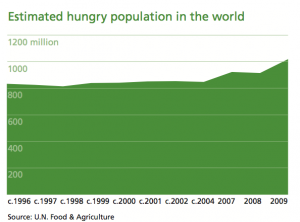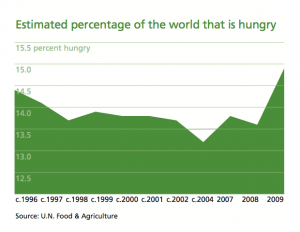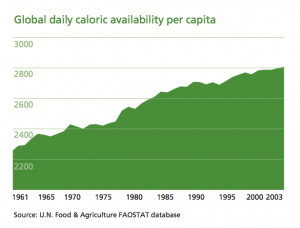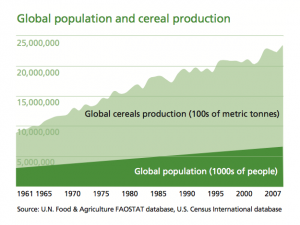The Scarcity Fallacy
For the first time in human history, the world is home to more than one billion hungry people. New data from the United Nations suggest that a higher proportion of the Earth’s people are hungry now than just a decade ago, the reverse of a long and otherwise positive trend.
The conventional wisdom is that world hunger exists primarily because of natural disasters, population pressure, and shortfalls in food production. These problems are compounded, it is believed, by ecological crises and global warming, which together result in further food scarcity. Ergo, hunger exists simply because there isn’t enough food to go around. Increase the food supply, and we will solve the problem of hunger on a global scale.
Scarcity is a compelling, common-sense perspective that dominates both popular perceptions and public policy. But, while food concerns may start with limited supply, there’s much more to world hunger than that.
A good deal of thinking and research in sociology, building off the ideas of Nobel laureate economist Amartya Sen, suggests that world hunger has less to do with the shortage of food than with a shortage of affordable or accessible food.
Sociologists have found that social inequalities, distribution systems, and other economic and political factors create barriers to food access. Hunger, in this sociological conception, is part of the broader concept of “food security,” which the World Bank describes as the inability to acquire the food necessary to sustain an active and healthy life. A central sociological element of this is “food poverty.”The (Recycled) Rhetoric of Scarcity
The idea that hunger is due to scarcity has roots in Thomas Malthus’s classic 1798 book An Essay on the Principle of Population. Malthus predicted widespread suffering and death from famine would result from the planet’s inability to feed itself, stemming from its failure to cope with exponential population growth. Malthus turned out to be wrong—food production grew much faster than population—but his arguments have been recycled over generations, and today, especially with ongoing threats to Earth’s carrying capacity, they have come to define conventional wisdom on hunger in the mainstream media and general public as well as for policymakers.
Food scarcity has long been the focus of agencies such as the U.N. Food and Agriculture Organization (FAO), the U.S. Department of Agriculture, and the U.S. Agency for International Development. Each uses some version of the scarcity argument to shape food security and development policies in collaboration with global agribusiness and food scientists. In such arrangements, concerns about hunger are viewed as production, marketing, and logistics problems that have solutions in the market-based policies of the global food system.Fighting hunger from this approach means the top priority is reducing scarcity. This is most often addressed by increasing food yields with new technologies and by shipping food to more places more efficiently. The underlying goal in this approach is to facilitate what has been called the “supermarket revolution”—a term used by the World Bank to describe the growing reliance of global citizens on large-scale agricultural industries and commodity chains to obtain their food.
This supermarket model has created steady growth in the global import and export of food. But it can also produce its own problems and be counter-productive. What’s worse is that the increased prices that often accompany market-based production make food less affordable for those in need. Furthermore, increased production may do nothing at all to guarantee more food. For example, the market model has increased use of crops for biofuel, which shifts agriculture away from producing food. In an oft-cited Washington Post editorial, Earth Policy Institute president Lester R. Brown noted that the same amount of grain needed to fill an SUV’s 25-gallon gas tank with ethanol could feed a single person for a whole year.
The bigger problem with emphasizing food supply as the problem, however, is that scarcity is largely a myth. On a per capita basis, food is more plentiful today than any other time in human history. Figures on the next pages reveal that over the last several decades food production (represented here in a common staple, cereals) and the average daily food availability per capita have grown, outpacing what has been the most rapid expansion of human population ever. Data such as these from the FAO reveal that even in times of localized production shortfalls or regional famines there has long been a global food surplus.
The problem is ensuring access to this food and distributing it more equitably. A 2002 New York Times headline proclaiming “India’s Poor Starve as Wheat Rots” dramatically, if tragically, illustrates this point. Starvation amidst plenty has occurred in many a famine, as in Bangladesh in 1974 or Ethiopia in the 1980s. 
 Even Ireland during the Great Famine exported vast quantities of food. Hunger in contemporary world societies is often no different. Markets are overflowing and even when shortfalls occur in emergencies, the global surplus is more than adequate to address such concerns.
Even Ireland during the Great Famine exported vast quantities of food. Hunger in contemporary world societies is often no different. Markets are overflowing and even when shortfalls occur in emergencies, the global surplus is more than adequate to address such concerns.
Crop science can produce more food, and transportation and storage improvements can distribute greater amounts of it, but these don’t guarantee access for all—a scenario that became quite evident with the 2007 global food crisis and spikes in food prices. Indeed, the global supermarket revolution can actually be devastating and counterproductive on the local level when prices increase and make food unaffordable for hundreds of millions of people.
Scarcity, in short, isn’t the problem, and giving it undue attention reinforces many of the myths that get in the way of understanding hunger. In World Hunger: Twelve Myths, food scholars Frances Moore Lappé, Joseph Collins, and Peter Rosset have elaborated on this, addressing the problems of misplaced focus. Blaming population growth, food shortages, or natural disasters sidetracks attention from the challenges of the global food distribution system, the authors argue. They warn that free markets, free trade, food aid, or even green revolution technologies, for example, can all be barriers to obtaining food when inequalities are deeply ingrained. Rather than food scarcity, then, we should focus our attention on the persistent inequalities that often accompany the growth in food supply.
Beyond Scarcity
The basic statistics about world hunger are staggering—and revealing. Some 96 percent of hungry people live in developing countries and according to Unicef nearly a quarter of them are children. The U.N. World Food Programme notes that in developing countries, the poorest citizens spend upwards of 60 percent of their income on food. By way of contrast, according to a New York Times editorial the poorest Americans only spend between 15 percent and 20 percent on food. With declining disposable income, those who already may eat only two very simple meals each day now may have to cut back to one.
These statistics reveal a clear link between poverty and hunger. Two-thirds of the countries in the world with the most severe extreme poverty—rates greater than 35 percent—also have child hunger rates of 35 percent or more. 
 As evidenced by the prevalence of hunger in the world’s 77 low-income food deficit countries (LIFDCs) as designated by the FAO, poverty is inseparable from hunger and should thus be considered its primary root cause. No wonder the 2000 U.N. Millennium Summit concluded that the most serious problem confronting the world is persistent poverty and its connection to hunger. The prevalence of hunger in LIFDCs is particularly important because these countries are not only among the world’s poorest by World Bank classification standards but are also net importers of basic foodstuffs because they are unable to produce amounts to meet their own needs. This makes them more at risk in that they lack sufficient foreign exchange in the international marketplace, something further exacerbated by global price spikes like those experienced in 2007. As evidence of the prevalence of food insecurity in LIFDCs, 23 of the 25 countries with the highest rates of child hunger in the world are also designated as LIFDCs (the exceptions being Burma and Maldives) and they continue to be predominant well down this list. Without guaranteed entitlements or other assistance, hunger is certain to persist among these most vulnerable nations, where addressing it is least affordable.
As evidenced by the prevalence of hunger in the world’s 77 low-income food deficit countries (LIFDCs) as designated by the FAO, poverty is inseparable from hunger and should thus be considered its primary root cause. No wonder the 2000 U.N. Millennium Summit concluded that the most serious problem confronting the world is persistent poverty and its connection to hunger. The prevalence of hunger in LIFDCs is particularly important because these countries are not only among the world’s poorest by World Bank classification standards but are also net importers of basic foodstuffs because they are unable to produce amounts to meet their own needs. This makes them more at risk in that they lack sufficient foreign exchange in the international marketplace, something further exacerbated by global price spikes like those experienced in 2007. As evidence of the prevalence of food insecurity in LIFDCs, 23 of the 25 countries with the highest rates of child hunger in the world are also designated as LIFDCs (the exceptions being Burma and Maldives) and they continue to be predominant well down this list. Without guaranteed entitlements or other assistance, hunger is certain to persist among these most vulnerable nations, where addressing it is least affordable.
Moreover, most of the LIFDCs are in Sub-Saharan Africa, where very little progress on hunger has been made over the last couple of decades—children, for example, fare only slightly better now than in 1990, child hunger having declined only 0.5 percent. In contrast, the remaining regions of the world have made much larger gains; East Asia and the Pacific, for example, have reduced child hunger 16 percent. Stagnation in the African subcontinent can be attributed directly to its persistent and pervasive poverty and underdevelopment, which creates further problems with conflict, health crises, and political instability, among other problems that contribute to hunger.
The developing world isn’t alone in its hunger and poverty, though. Demand on food pantries in the United States is increasing according to a 2009 survey of food banks by the organization Feeding America (formerly America’s Second Harvest). Evidence of poverty and loss of employment income as a primary cause of food insecurity can be even more evident in stark contrast to the relative well-being of U.S. citizens or elsewhere in the industrialized world. Here, food scarcity isn’t even (or shouldn’t be) a consideration. In difficult times and tight budgets, as freelance journalist and senior fellow at the policy and advocacy organization Demos, Sasha Abramsky, found in Breadline U.S.A., families keep gas in the car to get to work, prescriptions filled, and the heat and lights turned on but often cut their food budgets, with the hope public or private assistance will help put dinner on the table.
Poverty, though, is only one form of inequality. Gender, ethnic, and other types of stratification have contributed considerably to hunger as well. Women are disproportionately likely to suffer from hunger, and in fact constitute approximately 60 percent of the world’s hungry. This is particularly troubling given that women do as much as 80 percent of the world’s agricultural labor, working land that in more than a few places they may not be legally entitled to own.
As we have found in our own work, countries with more gender inequality (especially in education) have the greatest degree of child hunger. Gender inequality also influences women’s health and access to contraception as well as limits their opportunities in society, potentially condemning them to lives where childrearing is their only opportunity for social status. In this context, large numbers of children may not be a cause of scarcity so much as a consequence of poverty and powerlessness.
Ethnic inequality can also contribute significantly to world hunger, especially in countries with marginalized minorities and a history or present situation of ethnic violence. Such “minorities at risk,” as social movements scholar Ted Gurr calls them in People versus States, have long been threatened with hunger. Eritrea, Indonesia, Rwanda, Sri Lanka, and the Sudan are among many such places. While contributing to rampant militarism and armed conflicts, ethnic discrimination also silently marginalizes minorities to less desirable lands and occupations. The effects of ethnic discrimination then go beyond immediate violence, creating market disruptions, dispersed labor, and land degradation that destroys what for many is their only chance to produce or earn money for food.
Further exacerbating the effects of these social inequalities, international food aid—initiated by the US government in the 1960s to remove surplus grain from domestic markets and assist military allies—has long been ineffective and misdirected. According to Public Law 480, U.S. aid must travel in U.S.-flagged vessels and depends on market surpluses. The results, critics contend, is that the major beneficiaries are not those in need of food but U.S. shipping companies, agri-business, and countries with geopolitical value for the United States.
Studies of who gets food aid partially support this criticism. In an article in Food Policy aid specialists Daniel C. Clay, Daniel Molla, and Debebe Habtewold, for example, found no relationship between need and food aid in Ethiopia. Food aid was instead allocated to areas where organizations had stable operations, to favored ethnicities, and to female and aged heads of households regardless of need. Tina Kassebaum, a senior research scientist at Strategic Research Group, has found that program aid (bilateral U.S. donations) is unrelated to a country’s share of child hunger, while emergency/project aid (multilateral World Food Programme donations) is targeted at needy countries.
Making matters worse, emergency food delivery, which has become one of the most visible forms of assistance to those in need of food, has been corrupt on many fronts in recent years. According to Michael Slackman at the New York Times, in Egypt, the government subsidizes flour so that it can be baked into bread and sold cheaply to the population. However, the aid is routinely diverted into the black market and sold at a much greater profit while corrupt inspectors are bribed to certify that it has gone to assist the hungry. In the Democratic Republic of Congo, a 15-year civil war has been fought between the remnants of the Hutu guerrilla force that perpetrated the 1994 Rwandan genocide and other parties. In refugee camps, food is often used as a weapon—camp guards allocate it to those who will keep order, not to those most in need, while also having connections to widespread use of rape. Grim reports such as these have appeared in media outlets such as The Guardian, The Gazette (Montreal), and the New York Times who further note a key tactic in this battle has been attacking food aid and relief convoys, leading to threat and withdrawal of relief agencies, thus further compounding hunger as refugees and internally-displaced persons flee for safety, left to fend for themselves. Similar patterns have occurred in Darfur and other conflict-ridden zones.
Some argue that corruption is a product of scarcity, and that if food did not have to be delivered to areas where it was in short supply such fraud would not exist. This argument is true to a point, but such disruptions in the food distribution chain are much more attributable to conflict and inequality, with power and powerlessness at the core of the problem. Corruption is simply another barrier to access—especially in times of acute conflict. Indeed, the poor and powerless are ultimately those most affected by these failures in the systems designed to help them.
Poverty, inequality, conflict, and corruption are all crucial contributors to world hunger, then. But what may be even more important and difficult to understand is how these can all fit together, reinforce one another, and even intensify the impacts of more basic food crises or the limits of various natural resources—that is, of scarcity itself. Environmental scarcity can, for example, be both a cause and a consequence of the inequalities associated with hunger. Entrenched poverty can contribute to further conflict and environmental destruction. This limits food access and reinforces a feedback cycle causing more conflict, which in turn creates more scarcity, and so on. As we’ve learned from Oxford economist Paul Collier’s The Bottom Billion, hunger can be a product of a vicious cycle in which violent conflicts borne of corrupt and repressive government, poverty, and ethnic marginalization reinforce one another.
Addressing Hunger
Addressing world hunger is difficult and complex. To do it properly, we must get beyond the limited rhetoric of scarcity and instead focus on the inequalities, social conflicts, and organizational deficiencies at its roots.
To get at inequality, policy must give attention to democratic governance and human rights, fixing the politics of food aid, and tending to the challenges posed by the global political economy. At the very least, food must be upheld as a human right. In Freedom from Want, for example, political scientist George Kent places hunger squarely in the discussion of politics and the global human rights system. In his view, for hunger to be adequately addressed there must be worldwide recognition of food as a fundamental human right bound up in international law. It is only in this way that that both moral and legal accountability for failing to meet the needs of those not empowered to ensure their own food security can be established. Connecting this to our own work, we have found that democratization and increased protection of political rights reduces child hunger, paralleling a reduction of ethnic and gender inequality. Recognition of this fundamental human rights premise could elevate hunger to a higher level in international discussions and ultimately render it a non-issue, safeguarding it from the negative impacts of inequality, conflict, and politics.Upholding this principle would also protect vulnerable citizens in industrialized countries who are finding it increasingly difficult to afford food as prices increase, real wages decline, and unemployment grows. Moreover, plans emphasizing nutrition and health, such as school feeding programs or those that target women, infants, and children, could be justified on the grounds of human rights and equal protection for the deserving poor entitled to assistance.
A second focus should be ensuring that international food aid actually gets to those in need, overcoming the problems of inefficiency and corruption that have long plagued such efforts. Fortunately, the news here is not all negative. Over the last decade international aid has moved toward less politicized emergency/project aid. Studies of the impact of this kind of food aid have revealed a relatively favorable picture, Still, this kind of aid, at best a temporary corrective, can be improved by attending more directly to the underlying conditions of poverty and inequality.
There is, for example, a longstanding debate over in-kind aid versus cash assistance. Oxfam International argues that the developed world should not dump cheap, subsidized food aid that undermines local food production and markets in the developing economies it purports to help. A better solution would be to provide direct cash assistance to promote food purchases in local or regional economies. Recognizing that many poor depend on land for their income, such an approach would channel money to those who need it most, rather than to global agri-business and shipping companies profiting from food aid politics (this is a more ecologically sound practice as well). If reformed and effectively managed with minimal corruption, this approach could have a huge impact at minimal cost.
Leading up to the 2009 G-20 meetings in London, World Bank president Robert Zoellick noted that it would cost less than one percent of the current U.S. stimulus package to save a generation around the world from poverty and its consequences, including hunger. An influx of money could stabilize hundreds of countries throughout the world, not just with regard to hunger but politics and social conditions as well.
Fiscal challenges are further complicated by the fact that they are intricately connected with the global political economy, a third focus area. A number of ideas exist for making the globalized world more equitable so that ending hunger is a significant positive outcome. Strategies should empower societies and individuals to become more food-sovereign (able to exercise power over their food decisions).
Promoting sustainable agriculture with an emphasis on local food systems and empowering farmers to compete in their own markets is one such dimension. It will reduce ecological scarcity and go far toward ensuring food security, and ultimately food sovereignty, while having the added benefit of injecting additional money into local communities.
Effective long-term solutions through development of production capabilities, however, won’t succeed unless ethnic and gender inequality are reduced or better yet, eliminated. Freeing ethnic minorities from the fear they will face violence if they come to aid distribution stations or, better yet, providing them with the tools to produce their own food and economic sustenance, will contribute greatly to reducing hunger. Too, providing women with control over childbearing, giving them access to education, allowing them the right to own land and businesses, and facilitating their economic activities with micro-credit and other innovations will significantly reduce hunger. Investing in the well-being of women and reducing gender inequality not only can improve their lives but benefit entire countries.
The challenge, in short, is to create a more equitable and just society in which food access is ensured for all. Food scarcity matters. However, it is rooted in social conditions and institutional dynamics that must be the focus of any policy innovations that might make a real difference.
Recommended Resources
Laurie DeRose, Ellen Messer, and Sara Millman, eds. Who’s Hungry? And How Do We Know? (United Nations University, 1998). A social scientific treatment of the causes and conceptualization of hunger as well as appropriate responses to it.
Food and Agricultural Organization of the UN. The State of Food Insecurity in the World (FAO, various years). An annual assessment of world hunger, including the latest figures and most recent policy discussions.
Amartya Senn. Poverty and Famines: An Essay on Entitlement and Deprivation (Oxford University Press, 1981). A presentation of “entitlement failure,” the seminal theory for understanding global hunger as connected problems of distribution, access, and the human causes of famine.
James Vernon. Hunger: A Modern History (Belknap Press, 2007). A useful historical account of evolving conceptions of world hunger.

Comments 5
BLOG ROUND-UP « New Politics Review
April 27, 2010[...] Stephen J. Scanlan, J. Craig Jenkins, and Lindsey Peterson: The scarcity fallacy [...]
zcato
May 6, 2010I find it amazing that the politics of food and food producers is so strong that these realizations haven't made their way into the minds of public policy makers. There are many cases in the developed communities of the world, especially in the US, where we see that a given "solution" is not working, but the profits are too good, or personal morals are too important for someone to let the situation change. The "war on drugs" is a great example of this. We have had severe prohibition for a number of years, and it hasn't worked, but in Portugal they decriminalized possession and they've radically changed the way that people seek treatment.
Food production increases, world hunger…also increases » Graphic Sociology
May 10, 2010[...] A good deal of thinking and research in sociology, building off the ideas of Nobel laureate economist Amartya Sen, suggests that world hunger has less to do with the shortage of food than with a shortage of affordable or accessible food.” –Stephen Scanlan, J. Craig Jenkins, and Lindsey Peterson, Contexts Vol. 9:1; Winter 2010, p. 3... [...]
Scarsity does not Exist
January 25, 2011[...] [...]
Elizabeth
December 12, 2012My relatives always say that I am wasting my time here at web, but I know I am getting
familiarity daily by reading thes pleasant content.